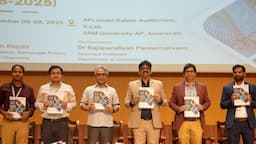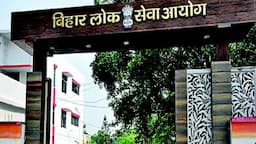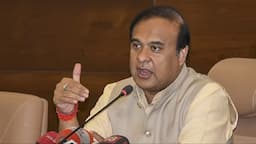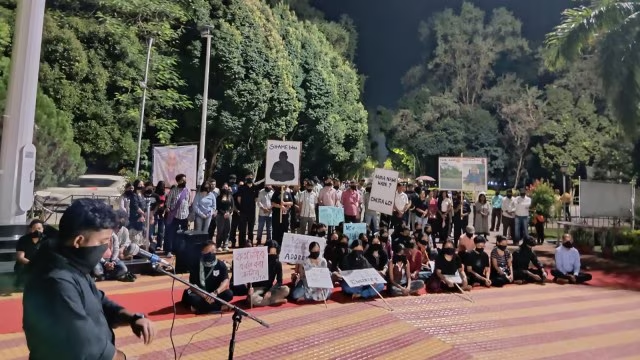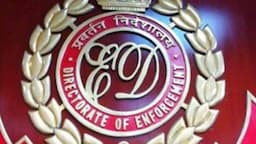Dr. S.S. Lohchab, Director of Rohtak’s Post Graduate Institute of Medical Sciences (PGIMS) shares his vision for the institution's future with Education Post’s Prabhav Anand. He emphasized the importance of digitalization, expanding facilities, and introducing new specializations to enhance healthcare delivery. Dr. Lohchab is dedicated to fostering international collaborations and strengthening community health initiatives, particularly in rural areas.
Q. Could you please start by sharing a bit about your background and journey in the medical field, leading up to your current role as the Director of PGIMS Rohtak?

I began my medical journey at Medical College, Rohtak (now PGIMS) in 1981, where I completed my MBBS, followed by an MS in General Surgery and an MCh in Cardiothoracic Surgery at GB Pant Hospital, Delhi. In 1997, I established the Department of Cardiac Surgery at PGIMS, introducing open-heart surgery to Haryana in 1999. I further advanced cardiac care by starting beating-heart coronary artery bypass grafting (CABG) in 2002 after training at Massachusetts General Hospital, Boston, USA.
Over the years, I launched several pioneering programs, including India’s first surgical treatment of atrial fibrillation using Cryo technology in 2009 and a comprehensive Mitral Valve Repair program in 2008. I also introduced the MCh Cardiothoracic Surgery course in 2011 and the B.Sc. Perfusion course in 2013. My work has earned international recognition, and I was nominated for the EACTS Techno College Award in 2013.
In 2021, I was appointed Director of PGIMS, Rohtak. Under my leadership, the institution has consistently ranked among India’s top 50 medical colleges. I also serve as President of the North Zone Association of Cardiothoracic Surgeons and am a member of the National Executive of IACTS.
Q. PGIMS has recently established a state-level organ transplant center. What were the challenges you faced during its setup and the impact it has had on patient care?
The establishment of a state-level organ transplant center involved logistical, regulatory, and financial challenges. Ensuring access to specialized staff and equipment, building public trust in the facility, and managing ethical considerations around organ donation were key considerations. However, with the start of Renal Transplant Program its impact was transformative, significantly improving patient outcomes and reducing the need for patients to travel out of state for such procedures. Renal transplant services are being provided free of cost under MMMIY. Now we are moving ahead with start of Liver & Heart Transplant Program.
Q. With your specialization in cardiac surgery, how do you plan to enhance the cardiology department at your institution in terms of research, training, and patient care?
With a specialization on cardiac surgery, our goals include advancing cardiology services by expanding research initiatives, improving training programs for young doctors, and upgrading clinical care to address the increasing burden of cardiovascular diseases. In 2021, we introduced DM Cardiology and DM Cardiac Anesthesia courses at PGIMS, Rohtak. We have established collaborations with national and international institutions, and in 2022, we began performing transcatheter Aortic valve replacement. Renowned Pediatric Cardiologist Prof. Anita Saxena from AIIMS, New Delhi, initiated pediatric cardiology services when she joined as Vice-Chancellor, UHS Rohtak in 2021. We also initiated surgery for complex congenital heart defects in collaboration with AIIMS, New Delhi. Our next step is to launch a Heart Transplant program at PGIMS, Rohtak.
Q. Research is a critical component of any medical institute. What are the current research priorities at your institution, and how are you fostering a culture of innovation?
At PGIMS Rohtak, we are focusing on cutting-edge research in areas like cardiovascular diseases, organ transplants, infectious diseases, and medical education. To foster innovation, we provide extensive resources and create an environment that encourages both faculty and students to engage in meaningful research.
We’ve initiated several research grant programs through our Research and Development cell. Faculty and postgraduates receive intramural grants, while undergraduates can participate in the University Undergraduate Research Scheme (UURS), similar to ICMR’s STS program, to get hands-on experience with research. Our laboratories are equipped with the latest technology to support high-level research.
Additionally, PGIMS is one of the selected centers for clinical trials under the ICMR INTENT initiative. We actively promote interdisciplinary collaborations, partnering with global research institutions, public health organizations, and biotech firms to enhance research impact. With a budget of Rs. 5 crore under the Research and Development Grant, we ensure financial backing for innovation.
To further encourage research, we organize an annual Research Conclave, where postgraduates and undergraduates present their work, and faculty members are recognized with awards for the best published papers. This has helped create a vibrant research culture across our institution.
Q. In your opinion, are Indian medical institutions providing enough support and opportunities for research and innovation? What steps can be taken to enhance this?
PGIMS Rohtak has made significant strides in fostering research, with well-established policies for extramural and intramural grants, supporting faculty, postgraduates, and undergraduates. As a recognized ICMR center for clinical trials, we played a crucial role in COVID-19 vaccine development, including COVAXIN trials, and we are actively involved in research on the dengue vaccine and cancer through ICMR’s Project DIAMOND. We are also engaged in the NCDC's projects on infectious diseases and antimicrobial resistance.
In the last five years, we’ve built a dynamic research environment with MOUs signed with other research organizations and universities, and we’ve launched a PhD program to promote advanced research. Our Multidisciplinary Research Unit (MRU), under the Department of Health Research, Government of India, has been instrumental in driving innovation. It has approved 56 projects, of which 16 are completed, and it continues to train hundreds of participants through workshops and seminars. We’ve also completed several important extramural projects, including studies on the cost-effectiveness of health services like Ayushman Bharat and Pradhan Mantri Bhartiya Janaushadhi Pariyojana.
While Indian institutions are advancing in research, there’s still much to be done. Improved infrastructure, more funding, and greater involvement from both government and private sectors are crucial. Encouraging interdisciplinary studies and fostering international collaborations will further elevate the research capabilities of Indian medical institutions.
Q. What are your thoughts on the current state of mental health among students in India, and what measures can be taken within educational institutions to better support their mental well-being?
We acknowledge the growing mental health issues that students face. We stress the significance of offering mental health support through counseling services, reducing academic pressure, and encouraging a balanced lifestyle for medical students. The institution provides counseling for medical students and faculty daily at the Institute of Mental Health. Additionally, the NMC has shared the report of the National Task Force on Mental Health and Well-being of Medical Students, and we are actively considering its recommendations for implementation.
Q. Do you believe the current medical curriculum adequately prepares students for real-world medical challenges? What improvements would you suggest?
While Indian medical education is comprehensive, there is room for improvement, particularly in offering more practical, real-world experience. To better prepare students for modern medical challenges, we need to incorporate more hands-on training, simulation exercises, and exposure to advanced technologies. Our curriculum committee regularly revises the syllabus, but there are a few key areas where improvements could be made:
1. Enhanced Clinical Exposure: Increasing early and consistent clinical rotations would help bridge the gap between theoretical knowledge and practical skills.
2. Integrated Learning: Interdisciplinary programs that blend medicine with technology, management, and public health should be encouraged to meet the evolving healthcare landscape.
3. Soft Skills Training: Emphasizing communication, empathy, and teamwork is essential for preparing students for patient-centered care.
4. Research and Innovation: A research-driven curriculum will promote critical thinking and problem-solving, essential skills for modern healthcare professionals.
5. Local Context Relevance: Incorporating modules on rural health, preventive care, and public health issues relevant to India and Haryana will better equip students to handle the unique healthcare challenges they will face in practice.
These changes would provide students with a more holistic, hands-on approach, aligning education with the realities of healthcare today.
Q. There is often criticism regarding the shortage of qualified faculty and resources in medical colleges. How can this issue be addressed effectively?
The shortage of qualified faculty is a common challenge in medical colleges. One possible solution could be to incentivize faculty positions through better compensation, provide opportunities for professional development, and create an attractive work environment to retain talent. For example, we could enhance the salary of Renal Transplant Surgeons and Physicians to kickstart our Renal Transplant Programme.
Q. What are the major differences you observe between public and private medical institutions in India, and how do these differences impact the quality of education?
Public institutions like PGIMS Rohtak, while often facing resource constraints, offer more affordable and accessible healthcare education. On the other hand, private institutions usually have better infrastructure but come with significantly higher costs. The balance between affordability and infrastructure is a key factor in determining the quality and accessibility of medical education.
However, I believe that the success of a student depends on multiple factors beyond the type of institution. The curriculum, institutional environment, and, most importantly, the individual’s motivation to learn play a crucial role.
Here are the main differences between public and private medical institutions in India:
1. Funding and Resources: Public institutions are government-funded, often leading to limited resources, whereas private institutions have more funds due to higher fees.
2. Fee Structure: Public institutions have lower fees, making education more accessible, while private institutions are typically more expensive.
3. Faculty and Teaching Quality: Public institutions generally attract more experienced faculty, thanks to job security and reputation, while private institutions may struggle with faculty retention.
4. Patient Load: Public hospitals deal with a higher patient load, giving students more clinical exposure. Private institutions may have fewer patients, limiting hands-on learning opportunities.
5. Research Opportunities: Public institutions often emphasize research, while private institutions may focus more on clinical teaching and infrastructure development.
These differences directly affect the quality of education by shaping the depth of clinical experience, research exposure, and the financial burden on students.
Q. How do you think Indian medical education stands in comparison to global standards? What can be done to make Indian medical graduates more competitive internationally?
Indian medical graduates are widely recognized for their technical skills, but there’s room to enhance their global competitiveness by aligning with international standards. While India has made great strides in medical education, our graduates often have less exposure to advanced technologies, interdisciplinary approaches, and global healthcare practices compared to their international counterparts.
To make Indian medical graduates more competitive on the global stage, we need to focus on the following:
1. Curriculum Modernization: Update the curriculum to incorporate global best practices and emerging fields such as artificial intelligence, genomics, and public health.
2. Research Focus: Boost research opportunities by providing more funding, mentorship, and improved infrastructure for research-driven education.
3. Clinical Exposure: Broaden clinical experiences by integrating newer technologies and encouraging international exchange programs to expose students to diverse healthcare settings.
4. Soft Skills: Place greater emphasis on communication, teamwork, and leadership skills to better prepare graduates for patient-centered care.
5. Global Partnerships: Foster collaborations with international institutions to promote knowledge exchange, training opportunities, and exposure to cutting-edge medical trends.
These steps can help Indian medical education reach a more competitive level internationally while enhancing the skills and global preparedness of our graduates.
Q. The recent incidents of NEET exam paper leaks have raised serious concerns. What measures do you believe should be implemented to prevent such occurrences and ensure the integrity of medical entrance examinations?
To address these issues, we need to implement much stricter security protocols for medical entrance exams. One effective approach would be to shift towards fully digital and encrypted systems for exam administration. This would minimize the chances of paper leaks. Additionally, involving third-party auditors to oversee the handling and security of exam papers could add an extra layer of accountability. We must enforce severe penalties for anyone found involved in malpractice to deter such incidents from happening in the future.
Q. As the Director of PGIMS Rohtak, what are your primary goals and vision for the institute in the next five years?
My vision for PGIMS Rohtak is to establish the institution as a center of excellence in research, patient care, and medical education. Over the next five years, we aim to fully digitalize all services, streamlining both patient care and administrative operations for enhanced efficiency and accessibility.

Expanding our facilities is another key goal, as it will enable us to accommodate a larger number of patients and students, ensuring that we continue to provide top-notch healthcare and education.
Additionally, we are focused on introducing new specializations and super-specializations to meet the evolving needs of modern medicine. International collaborations are also on the horizon, as they will allow us to bring global expertise and research opportunities to our institution.
Lastly, I am committed to strengthening our focus on community health, particularly in rural areas, to improve healthcare delivery and outcomes across Haryana and beyond. These goals reflect our ambition to elevate PGIMS Rohtak's role as a leader in the medical field both regionally and nationally.






